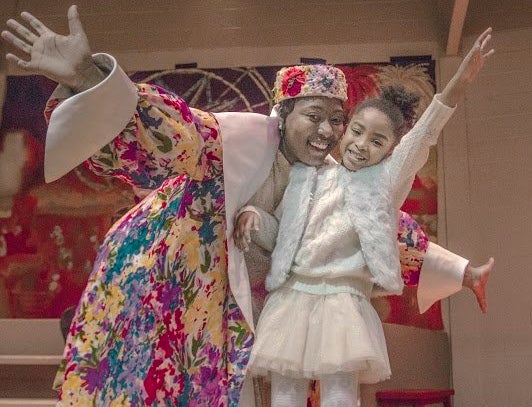Dunasha Payne always breaks down in tears when she sings "Home."
The song is the finale of "The Wiz," an urbanized, musical rendition of "The Wizard of Oz."
But to Payne, "Home" is a requiem for what she has left behind, and what she's so close to getting back: A life outside the walls of a maximum security prison in upstate New York, where she can properly raise her young daughter.
Just before Payne took the stage as Glinda the Good Witch at Bedford Hills Correctional Facility for Women, she cried. On that night in late January, Payne sang "Home" knowing that she wouldn't get there for another two years, after her sentence for manslaughter is served.
"I'm nervous," she told The Huffington Post from inside the prison's gymnasium, where she and her fellow inmates were about to perform the musical for an invite-only crowd of friends and family.
"But at the same time, I feel like I'm free -- I'm in prison, but this opportunity makes me feel like I'm free," she said.
Indeed, "The Wiz" gave Payne and the rest of the cast -- which included Dorothy played by Pamela Smart, whose notorious backstory inspired the Nicole Kidman film, "To Die For" -- the rare opportunity to perform behind bars, and conditioned them for life beyond Bedford Hills.
"The arts open a different pathway in your brain to make you think differently -- and when you think differently you behave differently."
Over the last year, Payne has been training with Rehabilitation Through the Arts, a 20-year-old program that brings theater, writing and music into the prison system. Currently in residence at five prisons in New York, including the Sing Sing, Bedford Hills, Fishkill, Green Haven, and Woodbourne Correctional facilities, RTA provides inmates with a slew of cognitive, social and technical skills that aren't necessarily available to the general inmate population on a daily basis.
Those skills keep inmates from coming back to prison. The national average of recidivism (the rate at which inmates are re-arrested or convicted within three years of their release) has hovered between 50 and 60 percent since RTA was founded in 1996. That rate plummets to about five percent for inmates who take part in RTA's programs, says founder Katherine Vockins.
"It sounds very simplistic, but the arts open a different pathway in your brain to make you think differently -- and when you think differently you behave differently," Vockins told HuffPost. "Our program teaches basic life skills, too: How to listen, work together, problem solve, understand deferred gratification, how to present on your feet without being afraid. It's all so important, both in and out of prison."
Numerous studies have found that education and arts inside the big house are gateways to lower recidivism. A 2013 study by the Rand Corporation notes that every dollar spent on vocational training and education inside prisons saves taxpayers $4 to $5 on re-incarceration costs. Studies commissioned by RTA found that inmates who engaged in the arts had a better chance at completing higher education degrees, and had a lower chance of committing violations behind bars.
Anecdotally, the program's impact is clear. Even inmates with life sentences -- like Mary Voorhees, who played the Lion -- say that training with the arts gives them a sense of purpose.
"It’s not an escape, it’s a tool," said Voorhees. "I figured when they said, 'you’re gonna spend the rest of your life in prison,' that was it ... But that's what makes RTA such a blessing, it's about rehabilitation. You learn how to deal with different people and different attitudes in a positive and constructive way. I never had that before."

Payne admits that, had it not been for her newfound ability to communicate with her fellow inmates, she might have earned herself more jail time.
"In here, we react. We go off our impulses," she said. "This teaches being humble, being patient, controlling your temper, thinking before you act ... I wouldn't be here today to see my family if I didn't have this."
The musical itself wasn't without its hiccups, given the restrictions inherent in a maximum security facility. Props and costumes were meager, the pit consisted of two people on one electric keyboard (though they worked wonders), and corrections officers lined the gymnasium -- a necessary but sobering reminder that we were, indeed, not in Kansas anymore.
Given the limitations, the actors themselves were impressive. The ensembles' tight, polished harmonies and breakout performances by the Scarecrow (played by inmate Judah Parham), the Wiz (inmate Kim Brown) and several others kicked the elephant out of the room for a while.
For the inmates, a year of training in the arts culminated in one night of feeling closer to home.
"I'm coming home!" Payne said. "This gave me a chance… Now you’re definitely gonna see me when I get out of prison. Don’t forget this face, you’ll definitely see me back on stage."
Every dollar spent on the arts helps keep inmates from re-entering the prison system. To learn how you can help support these programs, visit Rehabilitation Through the Arts, or find your local program at The Prison Arts Coalition.
Video Direction: Oliver Noble
Co-producers: Andy Campbell, Emily Kassie and Oliver Noble
Camera: Emily Kassie, Oliver Noble, Andy Campbell and Ric Savarese
Graphics: Tiara Chiaramonte, Dennie Bright and Adam Glucksman
Special thanks to Rehabilitation Through the Arts, Bedford Hills Correctional Facility and Technical Directions for making this story possible.